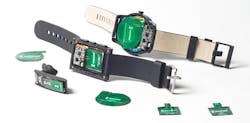What’s the Difference Between Qi and Other Types of Wireless Power Transfer?
Download this article in PDF format.
Apple announced that its iPhones, AirPods, and other accessories will all include Qi (pronounced “chee”) wireless charging. The Qi standard is one type of wireless power transfer, and certain to be a popular one due to Apple’s adoption. However, other types of wireless power transfer, such as AirFuel Resonant, proprietary near-field magnetic coupling (NFMC), radio frequency (RF), and ultrasound offer different value propositions.
The purpose of this article is to explain the key differences between Qi and other types of wireless power transfer technologies. The focus is on interoperability, adoption, use case, technology readiness, and safety and regulatory.
Interoperability
The No. 1 value-added differentiator for Qi is interoperability. If you see the Qi logo on a product, it is Qi-certified. Qi-certified devices (e.g., phones) are guaranteed to work with Qi-certified transmitters (e.g., charge pads, enabled autos, embedded furniture). This is important in the world of consumer electronics, where users can expect to have Qi transmitters in common locations throughout their daily life: home, car, office, coffee shops, airports, hotels. For the foreseeable future, the vast majority of consumer electronics will be Qi devices due to the benefits of interoperability and leveraging a common infrastructure.
AirFuel is another standard that offers interoperability using a different type of protocol, frequency, and process than Qi. Theoretically, AirFuel promises the same interoperability benefits as Qi (all AirFuel devices will work with all AirFuel transmitters), but the current reality is that Qi has scale via adoption that AirFuel can’t match.
Proprietary NFMC is, by definition, “proprietary” or “non-interoperable” with other devices. Proprietary systems don’t make sense for consumer mobile devices, but make a lot of sense for non-consumer devices like medical tools/devices, commercial-grade equipment, industrial electronics, unique form-factor devices, etc. There are at least three specific reasons why products may not want interoperability:
1. Device security
- Eliminate workers from charging their work devices in a public space and forgetting them
- Exposing devices to data vulnerability through public infrastructure
2. Safety
- Safety hazards caused by using personal devices on work equipment (e.g., delivery drivers charging personal cellphones on auto transmitters meant for handheld inventory trackers)
3. Unique use cases
- The Qi and AirFuel standards have specific use-case constraints that don’t suit all applications
RF and ultrasound are each in very early stages of development. Individual companies are launching “standards” (such as Ossia’s “Cota Standard”), but the standards are unlikely to become ubiquitous without much broader support from ecosystem partners and further technology readiness. Interoperability is theoretically possible, but years away due to the time and cooperation involved in real standards development.
Adoption
Qi technology is undoubtedly the leader in number of mobile devices deployed worldwide. Apple, Google, HTC, LG, Motorola, Nokia, and Samsung have launched Qi mobile phones (note: Google added Qi for Nexus 4, but dropped it from future models citing “slow charging times” that must be addressed before they include it again). Likewise, infrastructure adoption is unparalleled with Qi included in over 35 automotive models, IKEA furniture, Corian countertops, and standalone Qi transmitters of different shapes, colors, and sizes (to name only a few…).
AirFuel adoption is limited mostly to pilot scale. Dell launched a laptop in 2017; LG launched a limited-edition phone; and a variety of infrastructure deployments and accessories have pilot deployments in hotels, sports venues, airports, and coffee shops around Asia, Europe, and the U.S.
Proprietary NFMC has surprising levels of deployment, partially owed to the fact that certain niches have been using wireless power since the 90s. For example, implanted neurostimulators, electronic toothbrushes, and industrial equipment interconnects have been leveraging magnetic-coupling technology for over two decades. Granted, the technology has evolved to be much smaller, faster, and more user-friendly today, but millions of products have been shipping annually using proprietary near-field magnetic coupling since the early 2000s.
RF has no major commercial deployment, but has been impressively displayed by a variety of technology developers, including phone-charging demos where multiple phones are charged simultaneously at distances up to 15 feet away from the source. Most companies developing RF technology are in the pre-regulatory phase of development or have created off-shoot products that utilize RF technology, but at distances substantially lesser than the ultimate promise of RF.
Ultrasound is in the earliest stage of all. Limited demos have been provided, but no commercial products are available. The few demos offered are similar to RF demos in that they appear to slowly charge cell phones at distances of a few meters away from the source. The development efforts seem to be early stage and potentially still confronting fundamental challenges.
Use Case
The main value of Qi is that it’s interoperable and going to be everywhere. The main limitation of Qi is the use case. Qi relies on tightly coupled technology, low frequency, and limited in-band communication. For users, this means that device separation is limited to 3-5 mm, flexibility is limited, and the promise of simultaneous charging and data-transfer rate depends on an external data protocol.
There are workarounds for most of the limitations. For example, multiple-source power supplies and coil arrays can be used to provide greater orientation flexibility. The challenge, however, is cost of those complex systems and challenges with backwards compatibility. Over time, the technology and use case will improve. For now, this is the main shortcoming of Qi.
NuCurrent’s high-efficiency wireless power solutions are frequency-independent and frequency-compliant across the Wireless Power Consortium (Qi) and AirFuel Alliance.
AirFuel Resonant’s major promise is use case. AirFuel utilizes loosely coupled technology, which means that multiple devices can charge from a single transmit coil simultaneously; orientation and distance (up to ~50 mm) is flexible; power levels can scale reasonably above 50 W; and device charging can be invisible and more intuitive (i.e., embedding transmitters under the counter versus visibly embedding in or on the counter).
For AirFuel to succeed, it needs adoption and scale. Superior technology and use case may win over customers in the long term, but there’s a significant uphill climb given Qi’s current market leadership.
Proprietary NFMC has the most flexible use case because it’s proprietary. Everything from multiple-device charging with high power and unique environmental constraints down to low-power, low-cost 1:1 systems with no data transfer is fair game.
RF provides an extremely compelling use case. Whereas Qi offers millimeters of separation and AirFuel offers centimeters of separation, RF offers meters of separation. To date, long-distance RF power transfer still isn’t expected to deliver much more than 1 W of power, but it has the potential to be extremely valuable for low-power applications that rely on positional flexibility and meters of separation.
Ultrasound’s use case is less well known due to the limited technical information available. Most likely, the use case is somewhat similar to RF’s in that it has the potential to deliver low power over meters of distance.
Safety and Regulatory
Qi is implicitly safe due to magnetics and close-proximity coupling. It’s achieved regulatory approval in all major consumer markets and has limited issues with interference due to low frequency (~200 kHz), minimal radiation, and known shielding techniques.
AirFuel is also implicitly safe for similar reasons to Qi, but is challenged a bit more on interference-related issues due to higher frequency of operation (6.78 MHz) and generally larger transmitter antennas (for orientation flexibility). Multiple AirFuel systems have achieved worldwide regulatory approval, but regulatory is not a “given” (EMI/EMC issues, not safety issues) and should be carefully designed.
Proprietary NFMC can’t receive a blanket statement because every system is unique. NFMC (the same type of physics used by Qi and AirFuel) is generally safe. Designers must carefully consider EMI/EMC for each proprietary product design.
RF over distance hasn’t achieved regulatory approval. The power required in the transmitter to deliver usable power to devices multiple meters away is significant. In other words, current systems will need to be improved in order to provide enough power with low-enough emissions and high-enough efficiency to pass regulatory muster. This is a significant challenge since power reduces exponentially as it radiates away from a source due to the inverse-square properties of EM waves.
Ultrasound technology at low power is safe, but can it deliver meaningful amounts of power at meters of distance? Again, laws of physics are stacked against ultrasound technology, and the technology is too early stage for meaningful data to be publicly available. However, proponents of this technology are surely working on developing breakthroughs.



